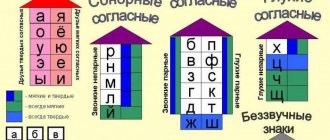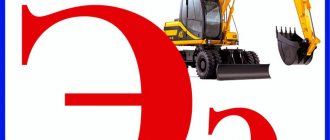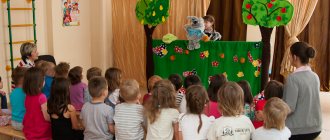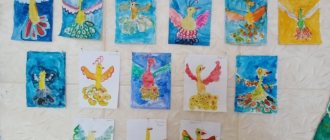Summary of a lesson in kindergarten on teaching literacy in the senior group
Summary of a literacy lesson on the topic “Forest”.
Senior group Description of the material: I offer you a summary of direct educational activities in the senior group (5-6 years old) on the topic “Forest”. This material will be useful for preschool teachers of older groups. This lesson summary is aimed at developing the ability to conduct sound analysis of words and graphically record sentences. Integration of educational areas: “Cognition”, “Communication”, “Socialization”. Program objectives: 1. To develop the ability to conduct sound analysis of words; 2. To develop the ability to graphically record a sentence; 3. Develop and improve children’s phonemic hearing; 4. Expand children’s ideas about the world around them; 5. Foster a caring attitude towards nature. Equipment: forest illustration; subject pictures of animals; chips; word schemes; 2 houses with pockets; graphical diagram of the proposal; hoops Vocabulary work: fox. Preliminary work: examination of illustrations depicting wild and domestic animals.
Course of the lesson
1. Organizational moment Educator: Today we have guests, let's introduce ourselves to them. Each of you will say your name and highlight the first sound that your name begins with. 2. Statement of the topic and purpose of the lesson Educator: What is the name of our lesson? What do we do in literacy? Do we need literacy in life? For what? Educator: Today we will play and do various exercises, you will receive chips for your work, and at the end you will count how much you earned. 3. Phonetic exercise – Listen to music. (Forest music sounds)
- Where can all these sounds be heard?
What is a forest? (Show illustration)
.
- Who lives in the forest? What can you hear in the forest? Let's remember forest sounds and designate them with chips. How does a strong wind blow? – What chip do we use to denote sound? How do the leaves on the trees rustle? – How do beetles buzz? (Zh-zh-zh)
– How do small mosquitoes ring?
(Z-z-z) 4. Sound analysis of the word “fox” Educator: Now listen to a riddle about one forest dweller: A cunning cheat, Red head, Fluffy tail - beauty, Who is it? (Fox.
)
Educator: Let's divide the word “fox” into syllables. How many syllables? (2) Educator: Let's say the word. Which syllable is pronounced with more force? Name the first syllable. – What was the first sound you heard? Let's denote it with a chip. Children lay out a diagram of the word “fox”. Educator: How many sounds are there in total? How many vowels are there in total? Do you agree? 5. Physical education for the eyes 6. Graphic recording of a sentence Educator : Let’s make a sentence about a fox and write it down using a diagram. (Children offer various options and write down sentence patterns). Educator: Who is this fox? What animal is this? Why? What other wild animals do you know? 7. Didactic game “What is this?” Educator: In the forest it can be green. What is this? (Leaves, grass, grasshopper, frog, spruce.) Educator: It can be long in the forest. What is this? (Snake, caterpillar, forest path.) Educator : In the forest it can be fast. What is this? (Hare, bird, squirrel.) Educator : In the forest it can be dangerous. What is this? (Snake, bear, poisonous mushrooms.) 8. Physical education lesson Teacher: Let’s play and relax in a forest clearing. The game is called "Make no mistake." Now music will sound, and you must run to the music around hoops in which there are pictures with animals. If the animal depicted in the picture lives in the forest, you run into the hoop at the end of the music, if not, then you are eliminated from the game. (Play 2 times) (Pictures of wild and domestic animals). 9. Game “Find a house for an animal” Educator: You know that many wild animals live in the forest. Let's play the game "Find a house for an animal." (Visibility of 2 houses: with one and two pocket windows)
.
If the animal's name has one syllable, then we move it into a house with one window; if it has two syllables, then into a house with two windows. Pictures: mouse, wolf, bear, fox, squirrel. 10. Summary of the lesson
Educator: What did we do today? What did you like most? What did you do well? What was causing the difficulty? Count how many chips each of you has? Well done!
We recommend watching:
Notes on educational activities in the senior group "Northern Adventures" Notes on a lesson on preparing children 5-6 years old for school Notes on the final lesson on teaching literacy in the senior group Notes on lessons on teaching literacy in the senior group. Sounds G, Gy. Letter G
Similar articles:
Summary of a mathematics lesson in the senior group of kindergarten. Geometric figures
Children's helpline
Consultation for parents on preparing children to learn to read and write
"Sound analysis of the word."
Hello, dear parents ! I propose to talk about preparing children for learning to read and write , namely about conducting a sound analysis of words . Written speech is formed on the basis of oral speech. And the first steps to learning to read and write should not be familiarity with letters, but the acquisition of the sound system of the language .
Each of us will smile, remembering the “folk”
rule of the Russian language:
“as it is heard, so it is written
.
Indeed, if a child does not pronounce a sound correctly , it is unlikely that he will write it correctly in a notebook in the near future.
It is necessary to pay attention not only to the correct articulation of sound, but also to the child’s ability to isolate, that is, to hear sounds in a word .
This skill is developed through the systematic work of both teachers in kindergarten and parents at home in games such as: “Name the first sound in the word ”
,
“Choose
a word ” ,
“Catch
a sound ” ,
“Determine the position
of the sound in a word ” ,
“Find a place for the picture”,
etc.
Dear parents, remember:
1. Sound - we hear and pronounce.
2. We write and read letters.
3. Sounds are vowels and consonants.
Vowel sounds can be sung with a voice, while the air coming out of the mouth does not meet any obstacles. Consonant sounds are sounds that cannot be sung, because... the air coming out of the mouth when pronouncing them meets an obstacle.
There are six vowel sounds: A, U, O, I, E, Y
There are ten vowel letters: A, U, O, I, E, Y - corresponding to the sounds and four iotated, which indicate two sounds: Ya-ya, Yu-yu, E-ye, Yo-yo.
Vowel sounds are indicated in red on the diagram.
Consonant sounds are soft and hard.
Always hard consonants: Zh, Sh, Ts.
Always soft consonants: Y, Ch, Shch.
Hard sounds are indicated in the diagrams in blue, soft sounds in green.
Teaching children the sound analysis of words begins with determining the sequence of sounds in a word : this sequence must be identified by repeatedly pronouncing the word with intonation highlighting each sound . So, when analyzing the word “BEETLE”
the child must pronounce it three times:
“ZZHUK”
,
“ZHUUK”
,
“ZHUK”
.
In order for a child to analyze a phenomenon , it must be understandable and materially presented.
Let's draw a diagram of the sound composition of the word : in the word “house”
three
sounds - let's draw three cells. And we’ll give the child this card: a house is drawn on it, so that it’s clear what word we’ll be analyzing , and under the house there’s a diagram of this word : the child already knows that words consist of sounds .
We show him that the cells under the picture tell us how many sounds there are in the word . “How many cells?” - "Three". - “How many sounds are in a word ?” - “Also three.” - “Let's look for these sounds . Say the word home so that I hear the first sound .” Our child already knows how to do this - he learned it at the first stage of education . “D-house,” the baby diligently pronounces. - “What is the first sound ?” - “D.” - "Very good! Let’s cover the first cell with a chip, what sound ?” - “D.”
You can use any material as chips: cut squares out of white cardboard or take an old mosaic and select white or yellow elements from it. Don't take red, blue, green ones - you'll need them later.
So, in front of the child is a diagram of the sound composition of the word “house”
, in which the first cell is already closed. We can move on.
“Let’s now say the word “home”
so that we can hear the second
sound , the first d - we already know.” “do-oh-oh”
with him .
Here a diagram of the sound composition of a word : you need to pronounce the word and at the same time move your finger along the diagram and stop it for a long time on the second cell. We keep our finger on the second cell of the diagram, and you and your child spend a long time saying “do-o-oh”
.
“What is the second sound in this word ?” - "ABOUT!" - "Great! Let’s designate this sound with a chip !”
The child takes a chip exactly the same as the first one and places it on the second square. “You see,” you continue, “we already know two sounds in the word “house”
.
Let's find the last sound in this word . Say the word “house”
so that the last
sound “” is heard.
And again you run your finger along the almost completed word pattern and say : “house-mmm.” “What is the last sound in the word house-mmm ?” “Mmm,” the child answers and puts the last, third chip on the diagram.
This is the first time a sound analysis of a word .
It would be good to repeat it again. But how? Take off the chips and start over? This is not interesting for the baby! No, it’s better to play the game “Who is attentive.” “And now,” you say, “I will call the sound , and you will remove its designation from the diagram. Let's see how attentive you are. Please remove the sound designation “d ” (blue chip)
For this type of analysis , the child is offered words of three sounds : poppy, house, cheese, cat, whale, ball, beetle, onion, forest, cancer.
When working with a child, you need to remember all the time: we teach him the sound analysis of words , we teach him to listen attentively to the word , to hear the sounds and its components. Therefore, the child must name the sounds as they are heard in the word .
This type of work with sounds is especially important for children with speech impairments. If you see that your child cannot cope the sound analysis of a word games to develop phonemic awareness.
In the process of analyzing three sound words, remind your child about the presence of vowels and consonants in the language . First, ask him to find the vowel sound in the word and replace the neutral chip with a red one.
Then remember that consonant sounds are soft and hard: hard sounds are denoted by blue chips, and soft sounds by green chips. Thus, now when drawing up word , the child will use chips of three colors.
All characteristics of sounds are given ORAL (no need to write down)
.
If the child wants, arrange the model of the word in the form of an application, so that you can then show it to someone else (ask your grandparents to “guess”
what these
“mysterious squares”
).




